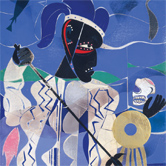A 2010 McKinney Avenue Contemporary exhibition of Sedrick Huckaby’s painting suite called A Love Supreme was as close to a popular sensation as the local art scene has experienced in some time. Fans swooned over the four large, enveloping works that featured multicolored quilts rendered with thick globs of paint. The pieces were visceral and rich, and the way they seduced viewers drew comparisons to the Rothko Chapel in Houston. Then there was the size. In total, the four paintings measured 80 feet in length. No one locally is painting canvases as large as the Fort Worth based Huckaby. Sometimes in painting, scale is equated to importance.
Huckaby’s most ambitious work to date is a painting called Hidden in Plain Site (2011), which is currently on view at the Amon Carter Museum of American Art. It is also the fi rst showing of a Huckaby painting in a major local museum, a high-water mark for an artist who has previously shown at museums in Waco, Tyler, and Abilene. Hidden in Plain Site comprises four massive canvases—each depicting his chosen image, the quilt—that are hung together to create one 18-by-14-foot oil painting.
The painting stretches all the way up the wall of a two story stairwell atrium. To view the work, it is not enough to stand in front of it. One must climb the staircase—literally ascend with the painting—to get a good look. That motion—the rising—is intrinsic not only to the experience of Huckaby’s piece, but to the layered meanings and symbolic references he hopes to conjure. The four-paneled piece is united by the way the folds in the four individually colored and patterned quilts suggest a circle, as well as a cross that is formed by the edges of the adjoined canvases. There are symbols hidden in the patterns of the quilts: more crosses, maps, and the triceps, a Nordic symbol that denotes divinity but today is more commonly recognized as the Mitsubishi emblem.
And yet what is most interesting about this latest piece is that it will not likely provoke the same enthusiastic response that greeted A Love Supreme. The scale of Hidden in Plain Site diminishes and diffuses its potency. While it is a monumental work, size doesn’t amplify the experience, but rather dampens it. Lost is the intimacy of Huckaby’s textured surfaces and the overwhelming blend of colors that swallow our perception. Without the provocation of an immediate, emotional response, we’re forced to deal more head-on with Huckaby’s symbolism, which he seems to stitch together, rather like a quilt.
That’s not a shortcoming, though. In fact, it makes this newer work much more interesting. Quilts have a deep resonance in African-American culture. The family heirlooms played a role in the story of emancipation by functioning as coded maps that guided escaped slaves to freedom. And while it has been popular of late to display actual handmade African-American quilts, such as the ones exhibited in upscale New York galleries, Huckaby’s act of repainting quilts disarms them as fetishized aesthetic objects while folding their weighted cultural meaning into the history of painting. The scale and shape of the piece suggest an altar piece, the folded fabrics are reminiscent of drapery in Renaissance paintings, and the patchwork of colors quote Byzantine mosaics. The cross formed by the edges of the canvases also offers a subtle play on the relation between surface and object. And the artist’s sometimes shaky, homespun execution is reminiscent of the AfriCOBRA movement of the 1960s, in which ostracized African-American artists took to creating work that drew content and mannerisms from black culture and outsider art to deliberately shun the art-world establishment.
Perhaps the most looming influence over Huckaby’s work, however, is readily available in another exhibition currently on view at the Amon Carter, this one by the late artist Romare Bearden. Bearden was an African-American artist whose career in New York spanned a tumultuous and exciting mid-century moment that saw the emergence of the abstract expressionism movement. Bearden’s relationship with abstract expressionism was an uneasy one, in part because of his figurative work, which often took up mythic subjects, was seen by some as out of step with the trajectory of art at the time. That hardly matters now. The Amon Carter exhibit focuses on an exquisite collection of domestic-size collages that restage scenes from Homer’s Odyssey in a way that conflates African, African-American, and modernist forms, mixing swathes of paper that recall Matisse’s late collages and a Fauvist color palette. Each tiny snip of paper is part of a delicate system of representation, a crisp, lively, and inventive vision.
The coordination of Huckaby’s work with Bearden’s is inspired. Both draw from similar wellsprings: their religious and cultural traditions, their mutual love of jazz, an adaption-reuse of traditional crafts at the service of high art, and a desire to explore universal human themes through repurposed mythological representation. Their voices also prove complementary. Like Huckaby’s, Bearden’s roots are in the South, and his work touches on this narrative legacy, blending it with a sharp wit characteristic of 1950s Harlem. Huckaby’s quilts and cruciform filter a variety of world art historical traditions through the memory of a domestic Texas setting that blurs home and the church.
Huckaby and Bearden are also similar in their place on the periphery of a contemporary culture. Huckaby has enjoyed some popular acclaim, but his figurative allusions, as well as the earnestness with which they invite a sincere emotional—almost sentimental—response, haven’t resonated with every critic and curator. Bearden, though, helps bolster the validity of the younger artist. Both are interested in a kind of lasting storytelling that feels currently out of fashion (or insufficiently politicized). And just as Bearden used myth to reframe the searching of the Civil Rights era, Huckaby’s work conjures a similar story about time, work, suffering, hope, and redemption, passed down and made present.





